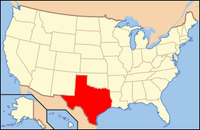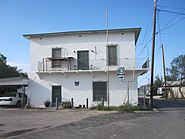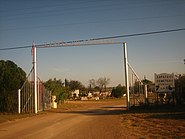| ||||||||||||||
| Zapata County, Texas | |
The front of the Zapata County Courthouse
| |
 Location in the state of Texas | |
 Texas's location in the U.S. | |
| Founded | January 22, 1858 |
|---|---|
| Named for | Colonel José Antonio de Zapata |
| Seat | Zapata |
| Largest community | Zapata |
| Area - Total - Land - Water |
1,058 sq mi (2,740 km²) 998 sq mi (2,585 km²) 60 sq mi (155 km²), 5.6 |
| Population - (2020) - Density |
13,889 |
| Congressional district | 28th |
| Time zone | Central: UTC-6/-5 |
| Website | www.co.zapata.tx.us |
Zapata County is a county located in the U.S. state of Texas. As of the 2020 census, its population was 13,889.[1] Its county seat is Zapata.[2] The county is named for Colonel José Antonio de Zapata, a rancher in the area who rebelled against Mexico.
Zapata County comprises the Zapata, TX Micropolitan Statistical Area.
The South Texas Oil Boom included wells drilled in Zapata County in the early 1920s through the work of Laredo industrialist Oliver Winfield Killam, a Missouri native who once served as an Oklahoma state legislator. It is east from the Mexico–United States border.
Geography[]
According to the U.S. Census Bureau, the county has a total area of 1,058 square miles (2,740 km2), of which 998 square miles (2,580 km2) is land and 60 square miles (160 km2) (5.6%) is water.[3] It is located in the Rio Grande Valley, on the shore of Falcon International Reservoir. It was previously linked to Mexico by an international bridge, but this was flooded when the Falcon Dam and reservoir was built. It is now linked to Mexico by the Falcon Dam Port of Entry.
Major highways[]
Adjacent counties and municipalities[]
- Webb County (north)
- Jim Hogg County (east)
- Starr County (southeast)
- Guerrero, Tamaulipas, Mexico (west)
National protected area[]
- Lower Rio Grande Valley National Wildlife Refuge (part)
Demographics[]
| Historical populations | |||
|---|---|---|---|
| Census | Pop. | %± | |
| 1860 | 1,248 | ||
| 1870 | 1,488 | 19.2% | |
| 1880 | 3,636 | 144.4% | |
| 1890 | 3,562 | −2.0% | |
| 1900 | 4,760 | 33.6% | |
| 1910 | 3,809 | −20.0% | |
| 1920 | 2,929 | −23.1% | |
| 1930 | 2,867 | −2.1% | |
| 1940 | 3,916 | 36.6% | |
| 1950 | 4,405 | 12.5% | |
| 1960 | 4,393 | −0.3% | |
| 1970 | 4,352 | −0.9% | |
| 1980 | 6,628 | 52.3% | |
| 1990 | 9,279 | 40.0% | |
| 2000 | 12,182 | 31.3% | |
| 2010 | 14,018 | 15.1% | |
| U.S. Decennial Census[4] 1850–2010[5] 2010–2020[1] | |||
As of the census[6] of 2000, there were 12,182 people, 3,921 households, and 3,164 families residing in the county. Zapata County is estimated to be the eleventh fastest growing county (+15.8%) in the state of Texas since the year 2000 (based on % of population change). The population density was 12 people per square mile (5/km2). There were 6,167 housing units at an average density of 6 per square mile (2/km2). The racial makeup of the county was 84.07% White, 0.41% Black or African American, 0.32% Native American, 0.19% Asian, 0.04% Pacific Islander, 12.64% from other races, and 2.33% from two or more races. 84.78% of the population were Hispanic or Latino of any race.
There were 3,921 households, out of which 43.20% had children under the age of 18 living with them, 64.20% were married couples living together, 13.00% had a female householder with no husband present, and 19.30% were non-families. 17.50% of all households were made up of individuals, and 10.30% had someone living alone who was 65 years of age or older. The average household size was 3.10 and the average family size was 3.52.
In the county, the population was spread out, with 33.00% under the age of 18, 10.00% from 18 to 24, 24.10% from 25 to 44, 18.60% from 45 to 64, and 14.30% who were 65 years of age or older. The median age was 31 years. For every 100 females there were 96.80 males. For every 100 females age 18 and over, there were 93.70 males.
The median income for a household in the county was $24,635, and the median income for a family was $26,722. Males had a median income of $26,294 versus $14,579 for females. The per capita income for the county was $10,486. About 29.30% of families and 35.80% of the population were below the poverty line, including 46.10% of those under age 18 and 21.30% of those age 65 or over.
Government and politics[]
Zapata County in most elections always overwhelmingly supported the Democratic Party. However, on three occasions, it gave record-setting margins to Republican presidential nominees when it delivered the highest percentage of the vote of any county in the nation to them. First in 1896 when it gave 96.3% of the vote to William McKinley, though he lost Texas as a whole (30.8%), but won the national election. The second time in 1908, when it went 99.1% to William Howard Taft, despite losing the state to William Jennings Bryan with just 22.4%. The third and final time was in 1912 when it again gave incumbent President Taft 80.9%, but against the state and nation's preference for Democrat victor Woodrow Wilson (Taft only received 9.5% statewide). It voted Republican for President (Warren Harding) in 1920 and then consistently voted Democratic until 2020, when Donald Trump defeated Joe Biden 53%-47%, about the same as the statewide margin.[7]
| Year | Republican | Democratic | Third party | |||
|---|---|---|---|---|---|---|
| No. | % | No. | % | No. | % | |
| 2020 | 2,033 | 52.48% | 1,826 | 47.13% | 15 | 0.39% |
| 2016 | 1,029 | 32.75% | 2,063 | 65.66% | 50 | 1.59% |
| 2012 | 997 | 28.14% | 2,527 | 71.32% | 19 | 0.54% |
| 2008 | 919 | 32.07% | 1,939 | 67.66% | 8 | 0.28% |
| 2004 | 1,228 | 42.37% | 1,662 | 57.35% | 8 | 0.28% |
| 2000 | 953 | 36.43% | 1,638 | 62.61% | 25 | 0.96% |
| 1996 | 521 | 21.27% | 1,786 | 72.90% | 143 | 5.84% |
| 1992 | 866 | 26.65% | 2,052 | 63.16% | 331 | 10.19% |
| 1988 | 958 | 30.56% | 2,171 | 69.25% | 6 | 0.19% |
| 1984 | 1,214 | 43.34% | 1,577 | 56.30% | 10 | 0.36% |
| 1980 | 874 | 41.01% | 1,218 | 57.16% | 39 | 1.83% |
| 1976 | 462 | 27.47% | 1,216 | 72.29% | 4 | 0.24% |
| 1972 | 695 | 47.51% | 768 | 52.49% | 0 | 0.00% |
| 1968 | 251 | 20.71% | 909 | 75.00% | 52 | 4.29% |
| 1964 | 135 | 11.77% | 1,009 | 87.97% | 3 | 0.26% |
| 1960 | 260 | 27.81% | 675 | 72.19% | 0 | 0.00% |
| 1956 | 637 | 41.80% | 886 | 58.14% | 1 | 0.07% |
| 1952 | 526 | 46.02% | 616 | 53.89% | 1 | 0.09% |
| 1948 | 414 | 39.54% | 632 | 60.36% | 1 | 0.10% |
| 1944 | 43 | 7.86% | 501 | 91.59% | 3 | 0.55% |
| 1940 | 495 | 38.70% | 784 | 61.30% | 0 | 0.00% |
| 1936 | 34 | 10.76% | 282 | 89.24% | 0 | 0.00% |
| 1932 | 24 | 8.14% | 271 | 91.86% | 0 | 0.00% |
| 1928 | 19 | 6.03% | 296 | 93.97% | 0 | 0.00% |
| 1924 | 197 | 39.56% | 300 | 60.24% | 1 | 0.20% |
| 1920 | 98 | 66.22% | 50 | 33.78% | 0 | 0.00% |
| 1916 | 214 | 89.17% | 26 | 10.83% | 0 | 0.00% |
| 1912 | 199 | 100.00% | 0 | 0.00% | 0 | 0.00% |
Education[]
All of Zapata County is a part of the Zapata County Independent School District.
Communities[]
There are no incorporated areas in Zapata County and hence no municipal governments.
Census-designated places[]
- Falcon Lake Estates
- Falcon Mesa
- Las Palmas
- Lopeño
- Los Lobos
- Medina
- Morales-Sanchez
- New Falcon
- Ramireno
- San Ygnacio
- Siesta Shores
- Zapata (county seat)
Gallery[]
See also[]
- National Register of Historic Places listings in Zapata County, Texas
- Recorded Texas Historic Landmarks in Zapata County
References[]
- ^ a b "State & County QuickFacts". United States Census Bureau. http://quickfacts.census.gov/qfd/states/48/48505.html.
- ^ "Find a County". National Association of Counties. http://www.naco.org/Counties/Pages/FindACounty.aspx.
- ^ "2010 Census Gazetteer Files". United States Census Bureau. August 22, 2012. http://www2.census.gov/geo/docs/maps-data/data/gazetteer/counties_list_48.txt.
- ^ "U.S. Decennial Census". United States Census Bureau. https://www.census.gov/programs-surveys/decennial-census.html.
- ^ "Texas Almanac: Population History of Counties from 1850–2010". Texas Almanac. http://texasalmanac.com/sites/default/files/images/topics/ctypophistweb2010.pdf.
- ^ "U.S. Census website". United States Census Bureau. https://www.census.gov.
- ^ "President Donald J. Trump narrowly wins Zapata County". http://www.krgv.com/news/president-donald-j-trump-narrowly-wins-zapata-county/.
- ^ Leip, David. "Dave Leip's Atlas of U.S. Presidential Elections". http://uselectionatlas.org/RESULTS.
External links[]
- Zapata County from the Handbook of Texas Online
- Current Hang Gliding Records

|
Webb County | 
| ||
| Guerrero Municipality, Tamaulipas |
Jim Hogg County | |||
 Zapata County, Texas | ||||
| Starr County |
| |||||||||||
| |||||||||||||||||||||||
|
| This page uses content from the English language Wikipedia. The original content was at Zapata County, Texas. The list of authors can be seen in the page history. As with this Familypedia wiki, the content of Wikipedia is available under the Creative Commons License. |






